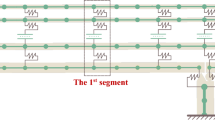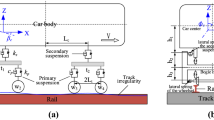Abstract
In order to investigate the seismic damage features of high-speed railway (HSR) China Railway Track Slab III (CRTSIII) slab ballastless track (SBT) simply supported bridge systems, a nonlinear finite element model of HSR CRTS III SBT simply supported bridge system was established. The damage mechanisms and peak and residual displacement distribution patterns of their critical components under seismic action were investigated. In addition, the sensitivity of rail irregularity to the seismic residual deformation in such critical components was analyzed. The results indicated that midspan piers and bearings are more susceptible to failure than side span piers and bearings, and fixed bearings are more prone to failure than sliding bearings. Fastener and isolation layer deformation increases sharply on both sides of the beam joint. Rail deformation exhibits a parabolic shape that is large in the middle and small at both ends. The critical components of even-span and odd-span systems have significantly different patterns of seismic deformation distribution. Rail irregularity is mainly attributable to bearing residual deformation, pier residual deformation, and fastener residual deformation successively, and the superposition of bearing residual deformation and pier residual deformation is approximately equivalent to rail deformation. Rail irregularity is most sensitive to pier deformation, followed successively by bearing and fastener deformation.






















Similar content being viewed by others
Data availability
Data will be available on request.
References
Liu L, Jiang L, Zhou W, Liu X, Feng Y. An analytical solution for the geometry of high-speed railway CRTS III slab ballastless track. Mathematics. 2022. https://doi.org/10.3390/math10183306.
Wei B, Hu Z, He X, Jiang L. System-based probabilistic evaluation of longitudinal seismic control for a cable-stayed bridge with three super-tall towers. Eng Struct. 2021;229:111586. https://doi.org/10.1016/j.engstruct.2020.111586.
Feng Y, Jiang L, Zhou W, Han J, Zhang Y, Nie L, et al. Experimental investigation on shear steel bars in CRTS II slab ballastless track under low-cyclic reciprocating load. Constr Build Mater. 2020;255:119425. https://doi.org/10.1016/j.conbuildmat.2020.119425.
Guo W, Hu Y, Gou H, Du Q, Fang W, Jiang L, et al. Simplified seismic model of CRTS II ballastless track structure on high-speed railway bridges in China. Eng Struct. 2020;211:110453. https://doi.org/10.1016/j.engstruct.2020.110453.
Gou H, Ran Z, Yang L, Bao Y, Pu Q. Mapping vertical bridge deformations to track geometry for high-speed railway. Steel Compos Struct. 2019. https://doi.org/10.12989/scs.2019.32.4.467.
Montenegro PA, Carvalho H, Ribeiro D, Calçada R, Tokunaga M, Tanabe M, et al. Assessment of train running safety on bridges: a literature review. Eng Struct. 2021. https://doi.org/10.1016/j.engstruct.2021.112425.
Montenegro PA, Ada RC, Carvalho H, Bolkovoy A, Chebykin I. Stability of a train running over the Volga river high-speed railway bridge during crosswinds. Struct Infrastruct E. 2019. https://doi.org/10.1080/15732479.2019.1684956.
Peixer MA, Montenegro PA, Carvalho H, Ribeiro D, Bittencourt TN, Calçada R. Running safety evaluation of a train moving over a high-speed railway viaduct under different track conditions. Eng Fail Anal. 2021. https://doi.org/10.1016/j.engfailanal.2020.105133.
Liu X, Jiang L, Lai Z, Xiang P, Chen Y. Sensitivity and dynamic analysis of train-bridge coupled system with multiple random factors. Eng Struct. 2020;221: 111083. https://doi.org/10.1016/j.engstruct.2020.111083.
Jiang L, Liu X, Xiang P, Zhou W. Train-bridge system dynamics analysis with uncertain parameters based on new point estimate method. Eng Struct. 2019;199: 109454. https://doi.org/10.1016/j.engstruct.2019.109454.
Guo W, Ye Y, Hu Y. Seismic damage analysis of bridge-CRTS III slab ballastless track system on high-speed railway. Soil Dyn Earthq Eng. 2022;161: 107416. https://doi.org/10.1016/j.soildyn.2022.107416.
Wang Z, Dueñas-Osorio L, Padgett JE. Seismic response of a bridge-soil-foundation system under the combined effect of vertical and horizontal ground motions. Earthq Eng Struct D. 2013;42:545–64. https://doi.org/10.1002/eqe.2226.
Chen L, Zhang N, Jiang L, Zeng Z, Chen G, Guo W. Near-fault directivity pulse-like ground motion effect on high-speed railway bridge. J Cent South Univ. 2014;21:2425–36. https://doi.org/10.1007/s11771-014-2196-9.
Wilson T, Chen S, Mahmoud H. Analytical case study on the seismic performance of a curved and skewed reinforced concrete bridge under vertical ground motion. Eng Struct. 2015;100:128–36. https://doi.org/10.1016/j.engstruct.2015.06.017.
Wei B, Zuo C, He X, Jiang L, Wang T. Effects of vertical ground motions on seismic vulnerabilities of a continuous track-bridge system of high-speed railway. Soil Dyn Earthq Eng. 2018;115:281–90. https://doi.org/10.1016/j.soildyn.2018.08.022.
Kang X, Jiang L, Bai Y, Caprani CC. Seismic damage evaluation of high-speed railway bridge components under different intensities of earthquake excitations. Eng Struct. 2017;152:116–28. https://doi.org/10.1016/j.engstruct.2017.08.057.
Zhi-ping Z, Jun-dong W, Shi-wen S, Ping L, Shuaibu AA, Wei-dong W. Experimental study on evolution of mechanical properties of CRTS III ballastless slab track under fatigue load. Constr Build Mater. 2019;210:639–49. https://doi.org/10.1016/j.conbuildmat.2019.03.080.
Jiang L, Peng K, Yu J, Zhou W, Zuo Y. The influence of trains on the seismic response of simply-supported beam bridges with different pier heights expressed through an impact factor. B Earthq Eng. 2022. https://doi.org/10.1007/s10518-022-01343-w.
Yu J, Jiang L, Zhou W, Peng K. Component Damage and Failure Sequence of Track-bridge System for High-speed Railway under Seismic Action. J Earthq Eng. 2022. https://doi.org/10.1080/13632469.2022.2030433.
Kim CW, Kawatani M, Kanbara T, Nishimura N. Seismic behavior of steel monorail bridges under train load during strong earthquakes. J Earthq Tsunami. 2013;07:1350006. https://doi.org/10.1142/S1793431113500061.
Kim C, Kawatani M. Effect of train dynamics on seismic response of steel monorail bridges under moderate ground motion. Earthq Eng Struct D. 2006;35:1225–45. https://doi.org/10.1002/eqe.580.
Liu X, Jiang L, Xiang P, Zhou W, Lai Z, Feng Y. Stochastic finite element method based on point estimate and Karhunen-Loéve expansion. Arch Appl Mech. 2021. https://doi.org/10.1007/s00419-020-01819-8.
Jiang L, Liu L, Zhou W, Liu X, Liu C, Xiang P. Mapped relationships between pier settlement and rail deformation of bridges with CRTS III SBT. Steel Compos Struct. 2020. https://doi.org/10.12989/scs.2020.36.4.481.
Liu L, Jiang L, Zhou W, Yu J, Peng K, Zuo Y. Study on the restoring force model for the high-speed railway CRTS III Slab Ballastless Track. Arch Civ Mech Eng. 2022. https://doi.org/10.1007/s43452-022-00472-y.
Liu L, Jiang L, Zhou W, Peng D, Liu X. Investigation of the seismic performance of CRTS III slab ballastless track of high-speed railway under low-cycle reciprocating load. Soil Dyn Earthq Eng. 2022;161: 107432. https://doi.org/10.1016/j.soildyn.2022.107432.
Code for seismic design of buildings. GB 50011-2010. Beijing: China Architecture & Building Press; 2016. (in Chinese).
Guidelines for seismic design of highway bridges. JTG/T B02-01-2008. Beijing: China Communications Press; 2008. (in Chinese).
The Pacific Earthquake Engineering Research Center. PEER Ground Motion Database. 2010. https://ngawest2.berkeley.edu/
Li C. Prefabrication and laying technology of CRTS III SBT. Beijing: China Railway Publishing House; 2016. (in Chinese).
Xing X. CRTS III SBT construction technology. Beijing: China Communications Press; 2015. (in Chinese).
Yu J, Zhou W, Jiang L. Response spectra of fitted post-seismic residual track irregularity for high-speed railway. Earthq Eng Struct D. 2022. https://doi.org/10.1002/eqe.3763.
Jiang L, Yu J, Zhou W, Yan W, Lai Z, Feng Y. Applicability analysis of high-speed railway system under the action of near-fault ground motion. Soil Dyn Earthq Eng. 2020;139: 106289. https://doi.org/10.1016/j.soildyn.2020.106289.
Zeng Z, Wang J, Shen S. Experimental study on evolution of mechanical properties of CRTS III ballastless slab track under fatigue load. Constr Build Mater. 2019;210:639–49. https://doi.org/10.1142/S021945542050011X.
Sun Y, Zhuo W, Fang Z. Definition and quantitative description of the seismic performance level of a regular bridge. J Earthq Eng Eng Vib. 2011;31. (in Chinese).
Guo W, Hu Y, Hou W, Gao X, Bu D, Xie X. Seismic damage mechanism of CRTS-II slab ballastless track structure on high-speed railway bridges. Int J Struct Stab Dyn. 2019. https://doi.org/10.1142/S021945542050011X.
Funding
National Natural Science Foundation of China, U1934207, Lizhong Jiang, 51408449, Lizhong Jiang, 5207082909, Lizhong Jiang, 5217083111, Lizhong Jiang, Natural Science Foundation of Fujian Province, 2022J05184, Xiang Liu.
Author information
Authors and Affiliations
Corresponding author
Ethics declarations
Conflict of interest
The authors declare that they have no known competing financial interests or personal relationships that could have appeared to influence the work reported in this paper.
Ethical approval
This article does not contain any studies with human participants or animals performed by any of the authors.
Additional information
Publisher's Note
Springer Nature remains neutral with regard to jurisdictional claims in published maps and institutional affiliations.
Rights and permissions
Springer Nature or its licensor (e.g. a society or other partner) holds exclusive rights to this article under a publishing agreement with the author(s) or other rightsholder(s); author self-archiving of the accepted manuscript version of this article is solely governed by the terms of such publishing agreement and applicable law.
About this article
Cite this article
Liu, L., Jiang, L., Zhou, W. et al. Analysis of seismic damage features of HSR CRTS III SBT simply supported bridge system. Archiv.Civ.Mech.Eng 23, 76 (2023). https://doi.org/10.1007/s43452-023-00619-5
Received:
Revised:
Accepted:
Published:
DOI: https://doi.org/10.1007/s43452-023-00619-5




